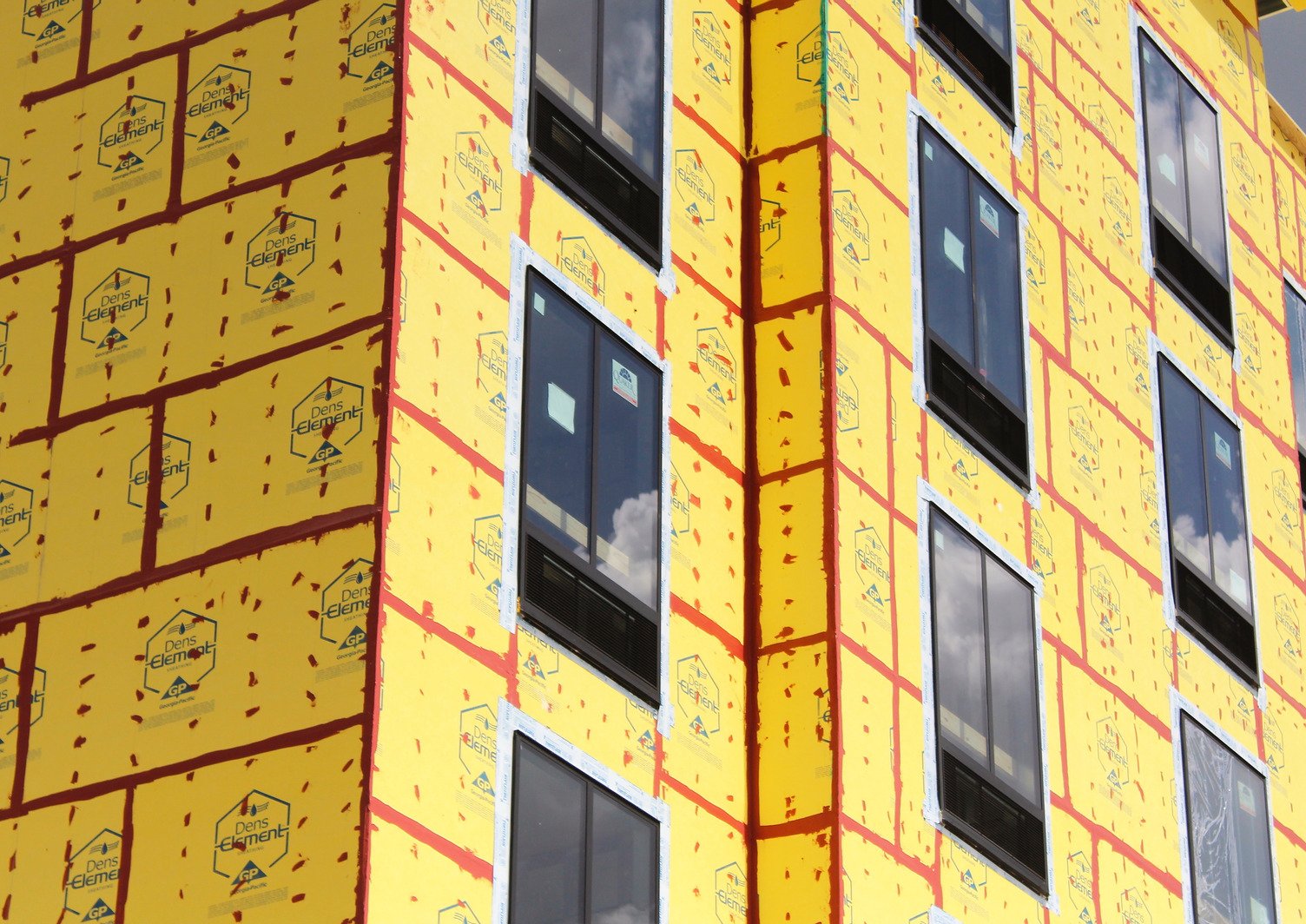Benefits of DensElement® Barrier System vs. Fluid-Applied Barriers

When it comes to protecting buildings from water intrusion, fluid-applied barriers are often touted as a more reliable alternative to traditional building wraps or self-adhered membranes. Although a fluid-applied membrane may offer certain benefits, it’s not a perfect solution — nor is it the only solution. And without careful installation, you could leave your building vulnerable to air leaks and water intrusion.
Fluid-applied membranes work much like paint, coating the building’s entire exterior. Contractors can use mesh or adhesive to seal joints and seams, and then coat those seals with more of the fluid-applied product. The liquid membrane offers an alternative to building wraps, which can be tricky to seal, and self-adhesive membranes can create a different set of issues, just like the way tape sticks to itself and can’t be pulled apart, the same can happen to self-adhered membranes, creating wrinkles and pockets where air and water can get trapped.
While contractors can avoid those problems by using a fluid-applied barrier, there are still several considerations they need to factor in. By comparison, the DensElement® Barrier System offers an all-in-one solution that addresses some key concerns.
Quality control needs
Most liquid-applied products must meet a prescribed dry mil thickness (of at least 40 mils) in order to be effective. If the application isn’t thick enough, the contractor needs to go back and recoat it until it meets the requirements. That creates more quality control work for the contractor than even traditional barrier types, explains John Chamberlin, senior product manager for the DensElement® Barrier System. “It ends up being just as slow as everything else because there’s all this quality control work to do,” he says. Because the DensElement® Barrier System includes the water resistive barrier (WRB) in the sheathing layer, contractors don’t have to worry about meeting a prescribed thickness across the face of the sheathing.
Not all substrates are created equal
Even if the contractor meets the correct thickness specifications for the fluid-applied barrier product, there still might be a need for additional coats because some substrate materials are more absorbent than others. Wood, for example, absorbs more water than gypsum. And some types of gypsum board absorb less water than others. So even though the wet mil thickness might seem right, it might not be enough to correspond with the absorbency of the substrate.
Weather dependency and cure times
Consider this scenario: You go through the trouble of making sure the fluid-applied product is thick enough and even added additional coats to accommodate the building’s substrate materials. Then it starts to rain. And all of that hard work washes away in an instant.
It takes a long time for fluid-applied membranes to dry and cure and avoiding rain-wash becomes a major concern with this kind of product. So contractors are often left playing the waiting game. “Not only does it make the wall vulnerable to conditions that could take away the WRB and air barrier, but it also means you can’t add cladding or anything else to the building until that WRB has dried out,” Chamberlin says.
Three functions: WRB, AB and sheathing
Whereas a traditional fluid-applied product serves primarily as a WRB and is separate from the wall’s sheathing layer, the DensElement® Barrier System performs triple duty as an all-in-one sheathing, water-resistive barrier and air barrier. The sheathing itself stops bulk water and wind-driven rain. Then by filling in all joints, holes and seams with PROSOCO R-Guard® FastFlash® liquid flashing, the system forms a continuous air barrier.
A shorter to-do list
Because the fluid-applied product needs to be installed separately from the sheathing, that means you have to add one more time-consuming step to your project. The DensElement® Barrier System, however, gets rid of that step by eliminating the need to install a separate water resistive barrier. And as Chamberlin explains: “The result is a very simple system without a lot of extra parts, pieces and accessories, and it does not take a lot of time to install.”
This article is intended solely as general information. Ultimately, the design and detailing of any project, assembly or system is the responsibility of a professional, and all projects must comply with applicable building codes and standards. For information concerning the limited warranty for the DensElement® Barrier System, visit the DensElement® page. GP Gypsum disclaims any responsibility or liability for the architecture, design, engineering or workmanship of any project, assembly or system.